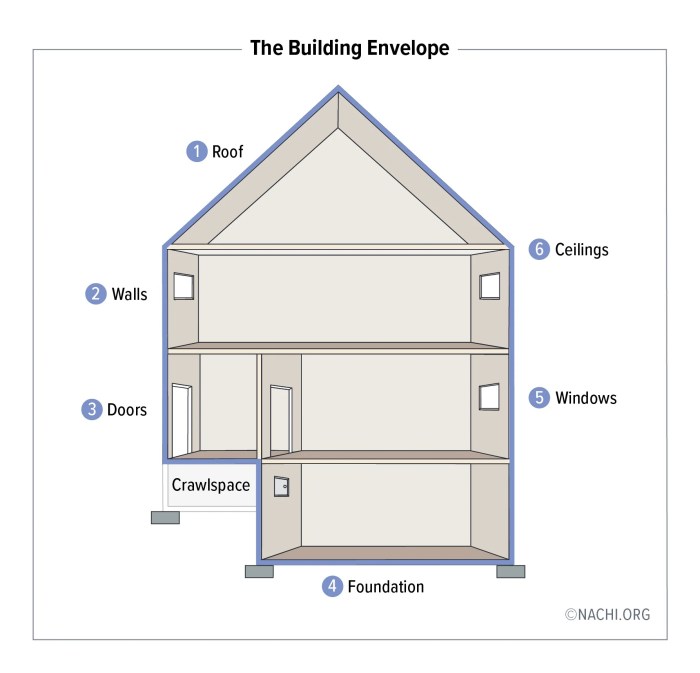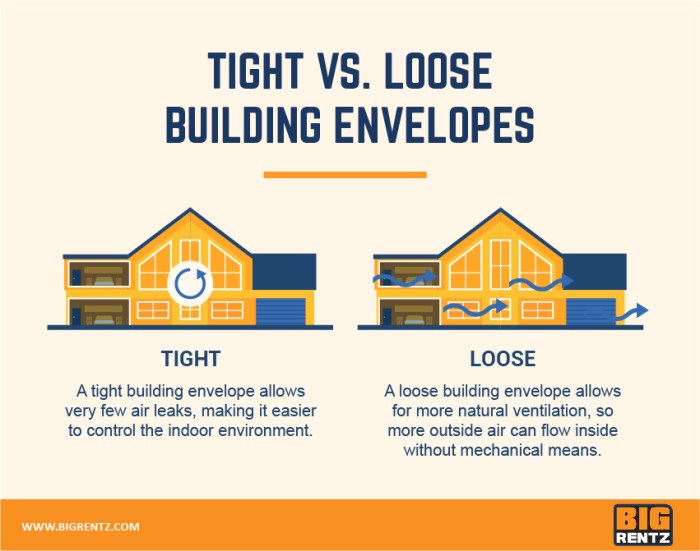Delve into the world of building envelopes with a comprehensive look at what they are and why they hold significant importance. From their fundamental functions to the impact on energy efficiency and indoor comfort, this topic is a gateway to understanding the core of construction.
Explore the various types of building envelopes, design considerations, and the essential maintenance practices that ensure longevity and performance.
Introduction to Building Envelope
A building envelope is the physical barrier between the interior and exterior environments of a structure. It includes all the elements that enclose the building, such as walls, roof, windows, doors, and foundation.
Primary Functions of a Building Envelope
- Weatherproofing: Protects the interior of the building from elements like rain, wind, and snow.
- Thermal Control: Regulates the temperature inside the building to ensure comfort and energy efficiency.
- Air Barrier: Prevents the infiltration of outside air, reducing energy loss and improving indoor air quality.
- Vapor Control: Manages moisture levels to prevent condensation and mold growth.
The building envelope serves several crucial functions:
Components of a Building Envelope
- Exterior Walls: Provide structural support and protection from the elements.
- Roofing System: Shields the building from weather and helps with insulation.
- Windows and Doors: Allow light and ventilation while maintaining energy efficiency.
- Foundation: Supports the structure and prevents moisture from seeping into the building.
Various components work together to form the building envelope:
Importance of Building Envelope
The building envelope plays a crucial role in the construction industry, impacting various aspects of a building's performance and longevity.
Energy Efficiency
The building envelope significantly influences energy efficiency by acting as a barrier between the interior and exterior environments. A well-designed envelope can minimize heat transfer, reducing the need for excessive heating or cooling systems. This, in turn, leads to lower energy consumption and decreased utility costs for the building occupants.
Indoor Comfort
Another key aspect of the building envelope is its contribution to indoor comfort. By effectively sealing the building from external elements such as wind, moisture, and temperature fluctuations, the envelope helps maintain a stable and comfortable indoor environment. Proper insulation and air sealing within the envelope play a vital role in regulating indoor temperatures and humidity levels, ensuring a pleasant living or working space for occupants.
Types of Building Envelopes
![What is Building Envelope? A Simple Definition [+Solutions] What is Building Envelope? A Simple Definition [+Solutions]](https://interior.haijogja.com/wp-content/uploads/2025/08/building-envelope-defined.jpg)
Building envelopes can be categorized into different types based on their characteristics and materials used. Understanding the various types of building envelopes is crucial in designing energy-efficient and sustainable buildings.
Opaque Building Envelopes
Opaque building envelopes are solid structures that do not allow light to pass through. They are typically made of materials like concrete, brick, or metal panels. These envelopes provide insulation and protection from external elements, making them essential for maintaining indoor comfort.
- Materials: Concrete, brick, metal panels
- Characteristics: Provides insulation, protection from elements
- Importance: Maintains indoor comfort, energy efficiency
Transparent Building Envelopes
Transparent building envelopes, on the other hand, allow light to pass through, creating a connection between the indoor and outdoor environment. Materials like glass are commonly used for transparent envelopes, enhancing natural lighting and views.
- Materials: Glass, polycarbonate
- Characteristics: Allows natural light, visual connection with outdoors
- Importance: Enhances aesthetics, promotes daylighting
Comparison of Building Envelope Materials
When comparing different building envelope materials, factors such as thermal performance, durability, and maintenance need to be considered. For example, while glass provides transparency and aesthetics, it may lack in insulation compared to opaque materials like concrete.
| Material | Advantages | Disadvantages |
|---|---|---|
| Glass | Provides natural light, aesthetic appeal | Less insulation, maintenance issues |
| Concrete | Excellent insulation, durability | Heavy, limited design options |
| Metal Panels | Lightweight, versatile | May corrode, less insulation |
Design Considerations for Building Envelopes
When designing a building envelope, several crucial factors need to be taken into consideration to ensure its effectiveness and sustainability. By focusing on these key aspects, you can optimize the performance of the building envelope and enhance the overall energy efficiency and comfort of the building.
Guidelines for Designing an Effective Building Envelope
- Consider the climate and location of the building to determine the appropriate insulation levels and materials.
- Ensure proper air sealing to prevent air leakage and maintain indoor air quality.
- Select durable and high-quality materials that can withstand environmental factors and minimize maintenance needs.
- Integrate efficient windows and doors to enhance natural light and ventilation while reducing energy consumption.
Factors to Consider When Designing a Sustainable Building Envelope
- Use eco-friendly and recyclable materials to reduce the environmental impact of the construction.
- Incorporate passive design strategies such as orientation, shading, and thermal mass to optimize energy efficiency.
- Implement green roofing or green walls to improve insulation, reduce heat island effect, and promote biodiversity.
- Integrate renewable energy systems like solar panels or wind turbines to supplement the building's energy needs.
Tips for Optimizing the Performance of a Building Envelope
- Regularly inspect and maintain the building envelope to identify and address any issues promptly.
- Monitor and control indoor humidity levels to prevent condensation and mold growth within the envelope.
- Consider retrofitting the building envelope with additional insulation or air sealing measures to improve energy efficiency.
- Engage with professionals such as architects, engineers, and energy consultants to ensure a well-designed and effective building envelope.
Maintenance and Repair of Building Envelopes

Regular maintenance and prompt repairs are crucial for ensuring the longevity and performance of building envelopes. By implementing proper maintenance practices, building owners can prevent costly damages and ensure the safety and efficiency of the structure.
Common Maintenance Practices for Building Envelopes
- Regular inspections to identify any signs of damage, such as cracks, leaks, or deterioration.
- Clearing debris, dirt, and vegetation from the roof and exterior walls to prevent water pooling and moisture penetration.
- Sealing gaps and cracks to prevent air leakage and water infiltration.
- Checking and maintaining the integrity of sealants, caulking, and weather-stripping.
Importance of Regular Inspections and Repairs
Regular inspections allow building owners to catch potential issues early on, preventing them from escalating into major problems that could compromise the building envelope's performance. Prompt repairs help maintain the structural integrity of the building and prevent water damage, mold growth, and energy loss.
How Proper Maintenance Can Extend the Lifespan of a Building Envelope
Proper maintenance not only ensures the optimal performance of the building envelope but also extends its lifespan. By addressing minor issues promptly and conducting regular inspections, building owners can prevent premature deterioration and avoid costly repairs or replacements in the future.
Closing Summary

In conclusion, the building envelope serves as a crucial element in construction, affecting everything from energy efficiency to comfort levels. By understanding its components and functions, one gains insight into the intricate world of architectural design and sustainability.
FAQs
What are the primary functions of a building envelope?
The primary functions include providing structural support, controlling temperature, and managing moisture levels.
How does the building envelope impact energy efficiency?
By effectively insulating the building, the envelope reduces energy consumption for heating and cooling.
What are some common maintenance practices for building envelopes?
Regular inspections, sealing cracks, and repairing damaged components are common maintenance practices.
















